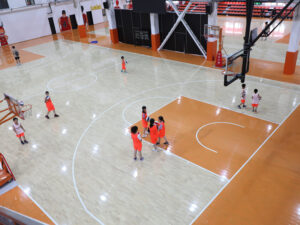Hey everyone, let’s talk basketball court floors. I know, I know, you’re thinking “boring,” but trust me, it’s way more interesting than you think! We’re not just talking about a flat surface here – we’re talking about the foundation for epic slam dunks, nail-biting free throws, and maybe even a few lucky bounces that turn the tide of a game.

When it comes to indoor basketball courts, wood flooring is the undisputed champion. It’s like the LeBron James of flooring – smooth, strong, and always ready to perform. But why is wood so special? Why not just go with something cheap and easy?
Well, let’s break it down. Imagine a perfectly polished hardwood floor. That’s the ideal playing surface for basketball. Here’s why:
Grip and Bounce: Wood flooring provides the perfect amount of friction, so players can move and plant their feet without slipping, but it also offers enough bounce for a satisfying swoosh when that shot goes in. It’s a delicate balance, but wood nails it every time.
Shock Absorption: We’ve all seen those crazy high-flying dunks. Hardwood flooring absorbs some of the impact, protecting players’ joints and knees from the pounding. That’s good news for everyone, especially those of us who aren’t quite as agile as Michael Jordan.
Durability: Basketball courts see a lot of action. From intense practices to high-pressure games, the flooring needs to be able to withstand the wear and tear. Hardwood floors are tough as nails and can handle all the running, jumping, and sliding that comes with the game.
Appearance: Let’s be honest, a beautiful hardwood floor just looks good. It adds a classic touch to any indoor court, making it feel like a real competition space.
Maple Hardwood – The King of the Court
Speaking of classic, there’s one type of wood that reigns supreme: maple hardwood. It’s the gold standard for basketball court flooring, used by the NBA and many other leagues around the world. Why? Well, maple hardwood is known for its:
Strength: Maple is incredibly strong and durable, meaning it can take a beating and still hold up. It’s like the Hulk of wood, but with a smoother finish.
Stability: Maple is less likely to warp or change shape over time, even with all that running and jumping. It’s a consistent performer, just like a reliable teammate.
Appearance: Let’s face it, maple hardwood looks amazing. Its grain patterns are beautiful and give the court a classic, elegant vibe. Plus, it ages gracefully, getting that warm, honey-toned look over time.
Beyond Maple: Other Options
Now, while maple is king, there are some other wood flooring options out there that are worth considering:
| Type of Wood | Pros | Cons |
|---|---|---|
| Hard Maple | Strong, durable, beautiful grain patterns | Can be more expensive |
| Soft Maple | Slightly softer than hard maple, but still durable | May not be as long-lasting as hard maple |
| Red Oak | Rich color, affordable | Not as hard or durable as maple |
| Birch | Hard and durable, budget-friendly | Grain patterns can be less attractive than maple |
The Bottom Line: For indoor basketball courts, wood flooring is the way to go. It’s the ideal playing surface, providing the perfect balance of performance, durability, and aesthetics. And while maple hardwood is the top choice for a reason, other wood options can also be good fits, depending on your budget and specific needs.
So, what do you think? What’s your favorite type of basketball court flooring? Have you ever played on a wood floor? Share your thoughts in the comments below!





